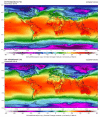The Global Emergency of Novel Coronavirus (SARS-CoV-2): An Update of the Current Status and Forecasting
- PMID: 32764417
- PMCID: PMC7459861
- DOI: 10.3390/ijerph17165648
The Global Emergency of Novel Coronavirus (SARS-CoV-2): An Update of the Current Status and Forecasting
Abstract
Over the past two decades, there have been two major outbreaks where the crossover of animal Betacoronaviruses to humans has resulted in severe acute respiratory syndrome coronavirus (SARS-CoV) and Middle East respiratory syndrome coronavirus (MERS-CoV). In December 2019, a global public health concern started with the emergence of a new strain of coronavirus (SARS-CoV-2 or 2019 novel coronavirus, 2019-nCoV) which has rapidly spread all over the world from its origin in Wuhan, China. SARS-CoV-2 belongs to the Betacoronavirus genus, which includes human SARS-CoV, MERS and two other human coronaviruses (HCoVs), HCoV-OC43 and HCoV-HKU1. The fatality rate of SARS-CoV-2 is lower than the two previous coronavirus epidemics, but it is faster spreading and the large number of infected people with severe viral pneumonia and respiratory illness, showed SARS-CoV-2 to be highly contagious. Based on the current published evidence, herein we summarize the origin, genetics, epidemiology, clinical manifestations, preventions, diagnosis and up to date treatments of SARS-CoV-2 infections in comparison with those caused by SARS-CoV and MERS-CoV. Moreover, the possible impact of weather conditions on the transmission of SARS-CoV-2 is also discussed. Therefore, the aim of the present review is to reconsider the two previous pandemics and provide a reference for future studies as well as therapeutic approaches.
Keywords: ACE2; COVID-19; SARS-CoV-2; diagnosis; epidemiology; inhibitors; pneumonia; temperature and humidity; therapeutics strategies; transmission.
Conflict of interest statement
The authors declare no conflict of interest.
Figures









References
Publication types
MeSH terms
LinkOut - more resources
Full Text Sources
Miscellaneous

